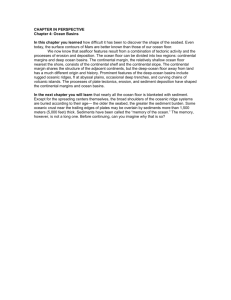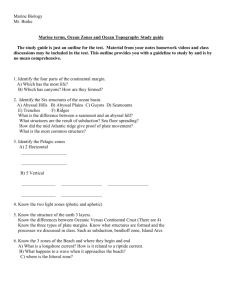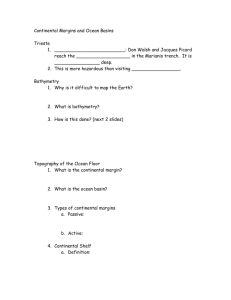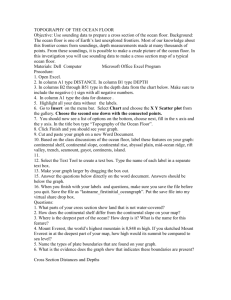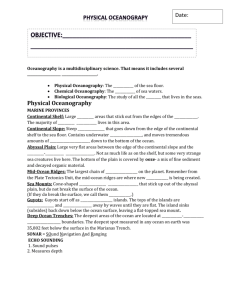Chapter 23 Reading Guide
advertisement
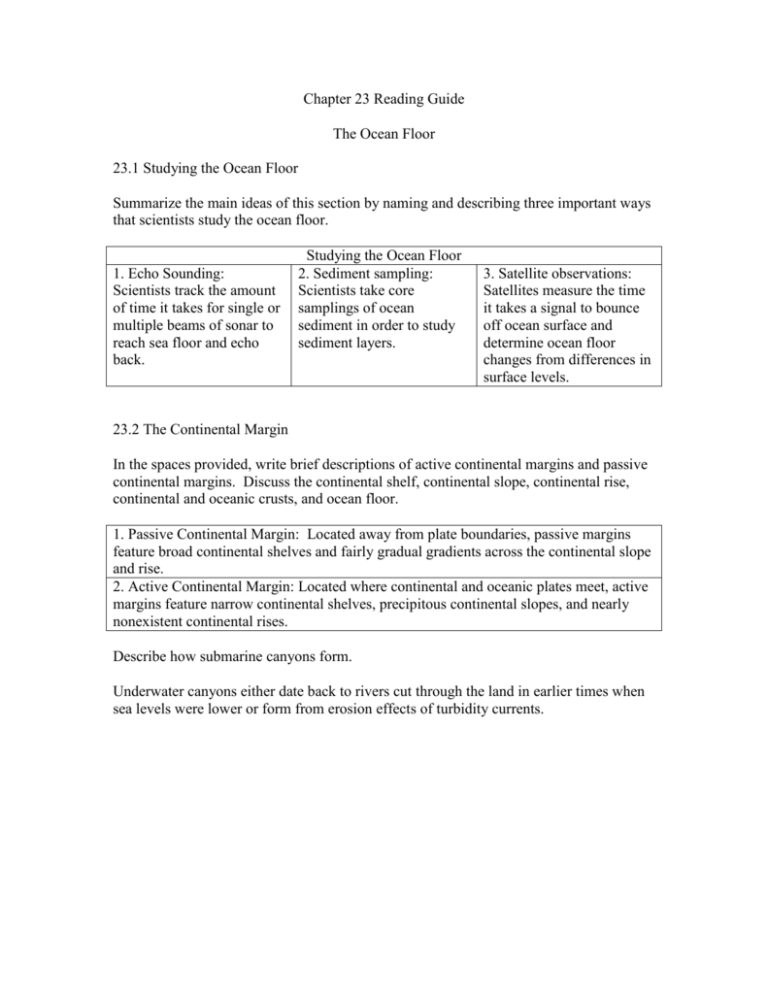
Chapter 23 Reading Guide The Ocean Floor 23.1 Studying the Ocean Floor Summarize the main ideas of this section by naming and describing three important ways that scientists study the ocean floor. 1. Echo Sounding: Scientists track the amount of time it takes for single or multiple beams of sonar to reach sea floor and echo back. Studying the Ocean Floor 2. Sediment sampling: Scientists take core samplings of ocean sediment in order to study sediment layers. 3. Satellite observations: Satellites measure the time it takes a signal to bounce off ocean surface and determine ocean floor changes from differences in surface levels. 23.2 The Continental Margin In the spaces provided, write brief descriptions of active continental margins and passive continental margins. Discuss the continental shelf, continental slope, continental rise, continental and oceanic crusts, and ocean floor. 1. Passive Continental Margin: Located away from plate boundaries, passive margins feature broad continental shelves and fairly gradual gradients across the continental slope and rise. 2. Active Continental Margin: Located where continental and oceanic plates meet, active margins feature narrow continental shelves, precipitous continental slopes, and nearly nonexistent continental rises. Describe how submarine canyons form. Underwater canyons either date back to rivers cut through the land in earlier times when sea levels were lower or form from erosion effects of turbidity currents. 23.3 The Ocean Basins Each feature of the ocean floor develops in response to particular factors. Define each feature and explain its cause. 1. Abyssal Hill: Small rolling, sediment-covered hills formed as the sea-floor surface near mid-ocean ridges. 2. Abyssal Plain: Flat of sea floor created by sediment brought from continents by turbidity currents and then spread out by the sea. 3. Deep-Ocean Trenches: Long, steep-sided troughs parallel to meeting of lithospheric plates, formed when one plate subducts beneath another. 4. Mid-Ocean Ridges: Undersea mountain ranges formed when lithospheric plates move apart, allowing magma to rise into the space and cool. 5. Seamounts/guyots: Cone-shaped mountain peaks formed originally by volcanoes; when the sea erodes away the top, seamounts become guyots. Name a specific geographic location where you might find each undersea feature: a) Abyssal Plain: Atlantic Ocean b) Abyssal Hills: North Atlantic Ocean c) Deep-ocean Trenches: Indian Ocean, western Pacific Ocean; Java Trench, Manilla Trench, Philippine Trench d) Seamounts: Hawaiian Islands 23.4 Ocean Floor Sediments Describe each of the four types of sediments in the appropriate box. List the origin, textures, and typical locations of each sediment type. 1. Terrigenous Sediments: 2. Hydrogenous Sediments: Bits and pieces of continents; carried by rivers or icebergs out to sea, particles range from gravel and sand to tiny grains and flakes, can travel great distance before settling to the ocean floor. 3. Calcareous Oozes: Chemical reactions cause minerals to crystallize from seawater, form very slowly on sea floor in lumps; found in all oceans and in some lakes. Shells and skeletons of marine animals or plants ; containing at least 30% calcium carbonate; dissolving into water as they fall; most common sediment – found on half of sea floor. Skeletons of marine life containing silicon dioxide; most common near equator and around Antarctica. 4. Siliceous Oozes: Explain why the study of ocean sediments is important. Ocean sediments contain information about Earth’s history. Sea creatures’ remains tell scientists about past changes in climate, water temperature, wind patterns, and glaciation. Understanding the past can help scientists predict and prepare for future changes.

